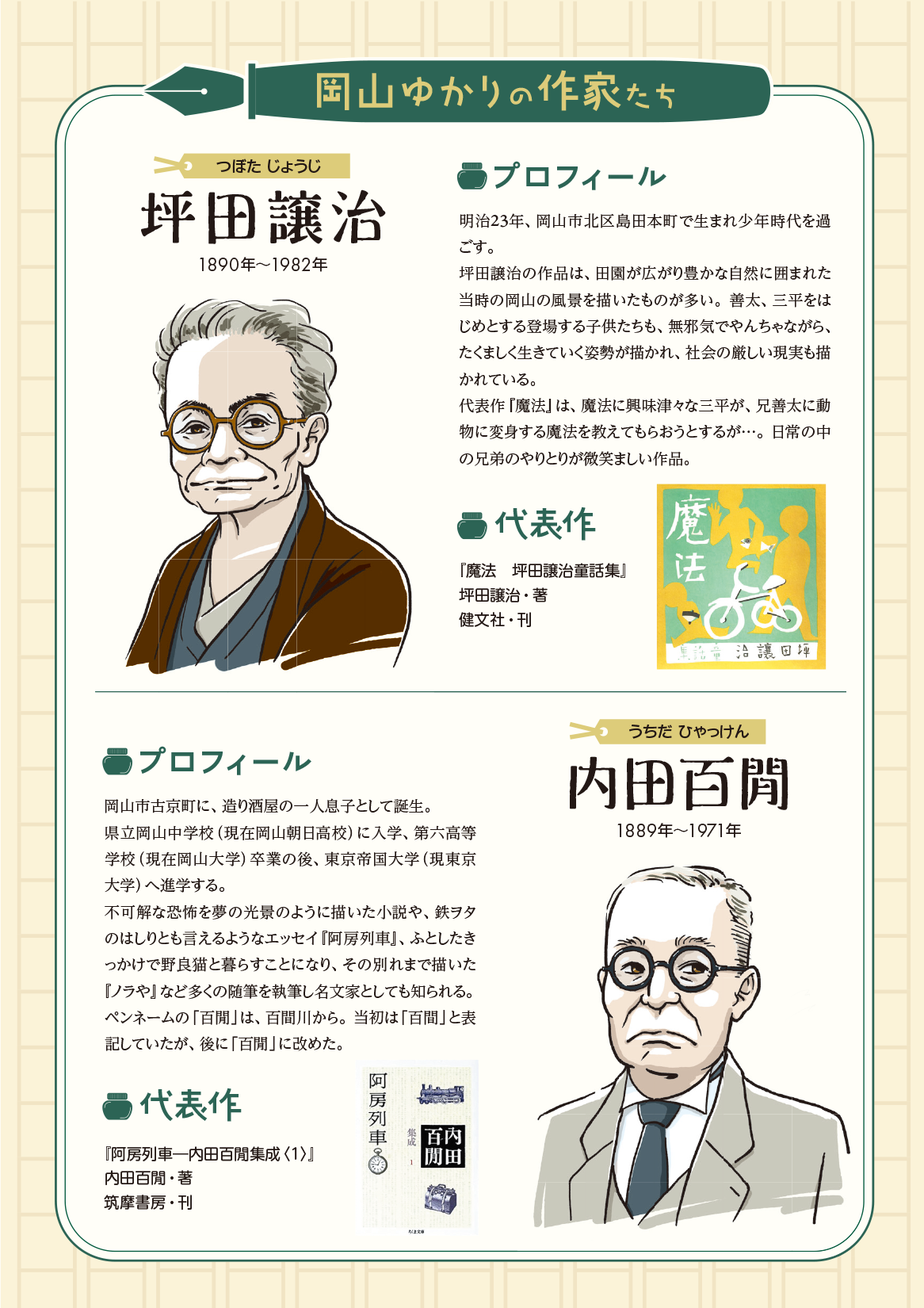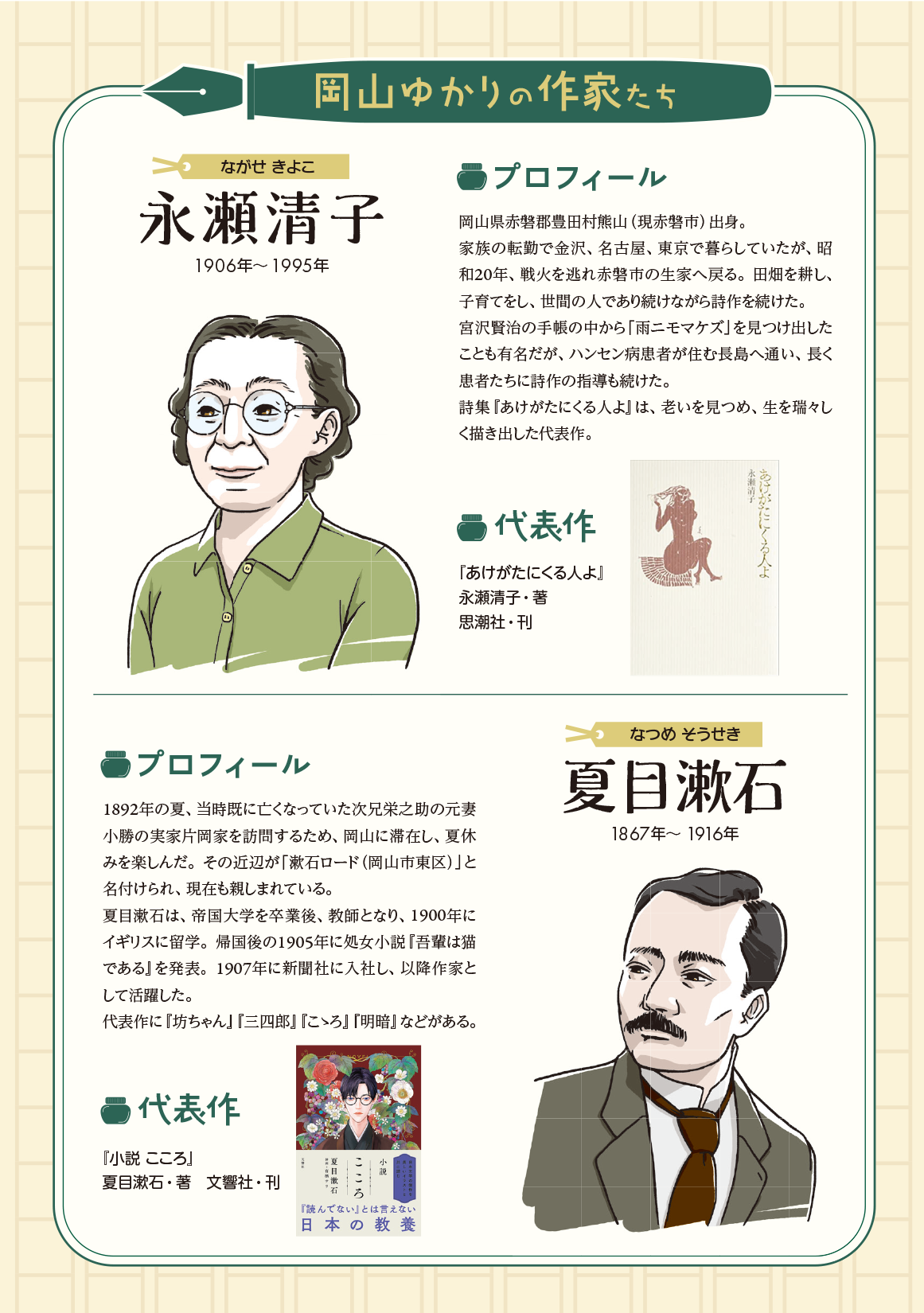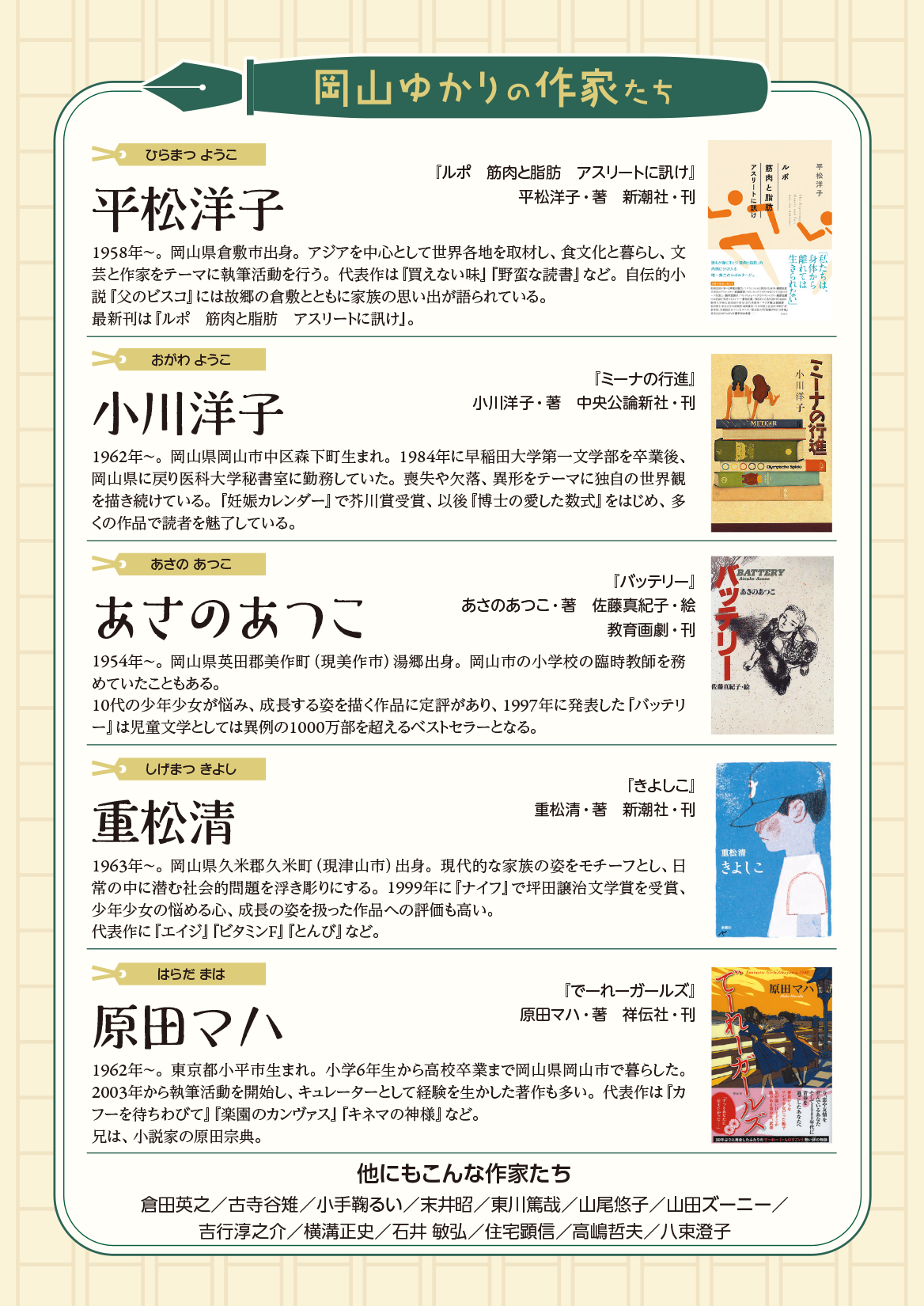[2.23.2023]
ID:68518
Introductioning of writersartists associated with Okayama
Joji Tsubota
Joji Tsubota was born in Okayama City in 1890, and spent his childhood.He depicted the landscape of Okayama such as wide spreading rice paddies and rich natural environment.Children named Zenta and Sanpei are playing in his works as innocent and mischievous. A strong attitude toward life and the harsh realities of society are also depicted.The interaction between two brothers makes us smile.
Atsuko Asano
Born in Mimasaka City in Okayama Prefecture.She worked as a teacher at an elementary school in Okayama City.She is well known for her works depicting teenage boys and girls' troubles and growth in her work “Battery” (1997). The “Battery” became a bestseller, selling more than 10 million copies.
Hyakken Uchida
Born in Furugyo-cho, Okayama City as the only son of a Sake (Japanese rice wine) brewer.He entered Okayama Prefectural Junior High School and graduated from the Sixth High School (the Okayama University). Hyakken went to Tokyo Imperial University (the University of Tokyo).He is known as a famous essay writer including a novel that describes inexplicable fears as if they were dream scenes. An essay “Abo Train can be said as train mania essay, and “Nora Ya,” is a work to describe an encounter with a stray cat led him to live with.The name “Hyakken” is from the name of a river running through in Okayama City “Hyakken River.
Yoko Ogawa
Born in Morishita-cho, Okayama City, Yoko graduated from Faculty of Literature in Waseda University in 1984.She returned to Okayama and worked in the secretary's office of a medical department of an university. Yoko has continued to depict her unique worldview with themes of loss, lack, and deformity.She was awarded the Akutagawa Prize for “Diving Pool.” Her works keep attracting readers with “The Housekeeper and the Professor”, “The Memory Police”, “Swim With an Elephant, Embracing a Cat” and many other works.
Shohei Kiyama
Shohei Kiyama is poet and novelist from Kasaoka City, Okayama Prefecture.He started out as a poet and later turned to fiction writer.After the World War 2 ended, he returned from China to Japan. He published “Tairiku no Hosomichi” and other works. Then he wrote short stories and essays in the style of private novels, working as a unique writer.
Kiyoshi Shigematsu
Kiyoshi was born in Kume-cho, Okayama Prefecture.Using the motif of the modern family, his works highlight social issues lurking in everyday lives.In 1999, he won the Joji Tsubota Literary Award for “Knife.” The “Knife” is highly regarded for his works dealing with a mind with troubles and conflicts of boys and girls in their growth.His representative works include “Age,” “Vitamin F,” and “Tombi.
Renzaburo Shibata
Renzaburo was born in Tsuruyama Village, Okayama Prefecture.His works are contemporary fiction and historical fiction.He won the Naoki-Sanjugo Prize for “The Descendants of Jesus.”The “Nemuri Kyoshiro” series was were on in Shukan Shincho “The Red Shadow Man” is a masterpiece of biographical fiction for Ninja lovers.
Shinko Tokizane
Shinko was born in Kuban Village, Okayama City.During the chaotic postwar period, she married into a merchant family in Hyogo Prefecture at the age of 17. While she was suffered from the violence of her husband who was a wounded soldier, she encountered Senryu in a newspaper column.Her collection of Senryu,“Yufuren” was published in 1987. The collection attracted women at the era. She brought a new style to Senryu world, and She was popular because of her style to express true feelings of women across the ages. She kept writing about her own experiences in the Great Hanshin-Awaji Earthquake in1995, and her works “Beyond the Grief and Suffering” encouraged many victims of the disaster.
Junichiro Tanizaki
In 1945, Junichiro Tanizaki evacuated to Tsuyama City and Katsuyama Town, Okayama Prefecture. He spent time there writing his masterpiece, “Hosoyuki.”In his early years, he was considered a member of the aestheticist school and is often discussed in a scandalous context, but he is known for his neat writing and skillful storytelling which differs from one work to another.His major works include “Shunkinsho,” “Hosoyuki,” and “In-ei Raisan.
Kiyoko Nagase
Kiyoko was born in Kumayama, Akaiwa-gun, Okayama Prefecture.She lived in Kanazawa, Nagoya, and Tokyo due to his family's job transfers, then returned to her birthplace, Akaiwa City to flee from the war in 1945.She continued cultivating her fields, raising her children and writing poetry.She is also famous for finding “Ame ni mo Makezu” in Kenji Miyazawa's notebook, and she continued to go to Nagashima Island where leprosy patients live. She kept teaching poetry to them for a long time.Heris collection of poems “Akegata ni Kuru Hitoyo” (Who Comes in the Dawn) is a masterpiece that portrays life in a fresh way.
Soseki Natsume
In the summer of 1892, Soseki stayed in Okayama to visit the Kataoka family, the parents of his second brother Einosuke's ex-wife Kokatsu. His brother was already dead at the time, and Soseki enjoyed a summer vacation.The area where Soseki stayed was named “Soseki Road,” and is still popular today.Soseki graduated from Imperial University of Tokyo, he became a teacher and studied in England in 1900.After returning to Japan, he published his first novel, “I am a Cat,” in 1905.He entered into a newspaper company in 1907,and became a writer.His representative works include “Bocchan”, “Sanshiro”, “Kokoro”, and “Mei-an”.
Maha Harada
Maha was born in Kodaira City, Tokyo.She lived in Okayama City from sixth grade through high school graduation.She began writing in 2003 and has published many books based on her experience as a curator.Her representative works include “Waiting for Kafu,” “Canvas of Paradise” and “The God of Cinema.”
Yoko Hiramatsu
Yoko was born in Kurashiki City, Okayama Prefecture.She has visited Asia and other parts of the world and writes on the themes of food culture, lifestyle, literature and writers.Her best-known works include “A Taste You Can't Buy” and “Savage Reading.Her autobiographical novel, “My Father's Bisco,” recounts her memories of her family.
Illustrations of writersdepicting artists associated with Okayama




Portrait: Studio Kai
Design: Nakahara
Planning Office
Text: 451 Books,
Keitaro Neki
